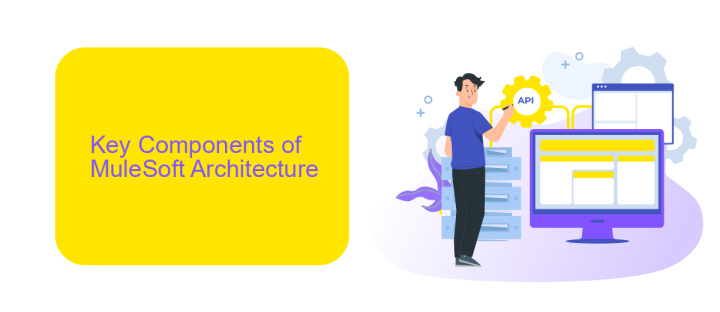What is MuleSoft Architecture?
MuleSoft Architecture is a comprehensive framework designed to facilitate seamless integration and connectivity across various applications, data sources, and devices. By leveraging APIs, it enables businesses to create a unified ecosystem that enhances operational efficiency and agility. This article delves into the core components and principles of MuleSoft Architecture, providing insights into how it simplifies complex integration challenges.
MuleSoft Architecture Overview
MuleSoft Architecture is designed to streamline the process of connecting applications, data, and devices through a unified platform. It leverages APIs to facilitate seamless integration across various systems, ensuring efficient data exchange and interoperability.
- API-led connectivity: MuleSoft's approach to integration, where APIs are used to connect and expose data and services.
- Anypoint Platform: A unified platform that provides tools for designing, building, and managing APIs and integrations.
- CloudHub: MuleSoft's cloud-based integration platform-as-a-service (iPaaS) for deploying and managing integrations.
- API Manager: A tool for managing and securing APIs, including policies, access control, and analytics.
- Runtime Manager: A centralized interface for managing Mule applications and APIs.
By utilizing MuleSoft's architecture, businesses can easily integrate with platforms like ApiX-Drive, which automates the data flow between various apps and services. This enables organizations to enhance operational efficiency and reduce the complexity of their integration processes.
Key Components of MuleSoft Architecture

MuleSoft Architecture comprises several key components that facilitate seamless integration and efficient data flow across various systems. The primary component is the Anypoint Platform, which provides a unified solution for API design, development, and management. Within this platform, Anypoint Studio serves as an integrated development environment (IDE) that allows developers to build, test, and deploy APIs and integrations. The platform also includes Anypoint Exchange, a marketplace for connectors, templates, and other reusable assets that expedite the integration process.
Another essential component is the Mule runtime engine, which executes the integration logic and ensures robust data processing. Additionally, MuleSoft's architecture leverages CloudHub, a managed cloud-based service that simplifies the deployment and management of integrations. For organizations looking to streamline their integration efforts, services like ApiX-Drive can be particularly beneficial. ApiX-Drive offers a user-friendly interface for setting up integrations between various applications and services without requiring extensive coding knowledge, thereby enhancing the overall efficiency and scalability of the MuleSoft ecosystem.
Integration Patterns Used in MuleSoft Architecture

MuleSoft architecture leverages various integration patterns to streamline and optimize the integration process. These patterns are essential for ensuring seamless communication between different systems, applications, and services. By implementing these patterns, organizations can achieve greater flexibility, scalability, and efficiency in their integration efforts.
- Point-to-Point Integration: This pattern involves direct communication between two systems or applications, allowing for straightforward data exchange.
- Message Routing: MuleSoft uses message routing to direct messages to appropriate destinations based on specific criteria, ensuring accurate and timely data delivery.
- Service Orchestration: This pattern coordinates multiple services to achieve a business goal, enabling complex workflows and processes.
- API-Led Connectivity: By exposing core systems through APIs, MuleSoft facilitates the creation of reusable and composable services, enhancing integration agility.
- Event-Driven Architecture: MuleSoft supports event-driven patterns, allowing systems to react to events in real-time, improving responsiveness and efficiency.
Additionally, services like ApiX-Drive complement MuleSoft by offering easy-to-use tools for configuring integrations. ApiX-Drive simplifies the setup process, enabling businesses to connect various applications and automate workflows without extensive coding. This synergy between MuleSoft and ApiX-Drive ensures robust and efficient integration solutions.
Benefits of Using MuleSoft Architecture

MuleSoft Architecture offers a robust and scalable solution for integrating various applications, data sources, and APIs. By leveraging MuleSoft, organizations can streamline their operations and improve efficiency. This architecture supports seamless communication between disparate systems, enabling businesses to adapt quickly to changing market demands.
One of the significant advantages of using MuleSoft is its ability to simplify complex integration processes. This is achieved through its user-friendly interface and pre-built connectors, which reduce the time and effort required for integration. Additionally, MuleSoft's architecture is highly flexible, allowing for easy customization and scalability as business needs evolve.
- Enhanced connectivity between systems
- Reduced integration time and costs
- Improved data accuracy and consistency
- Scalability to accommodate business growth
- Robust security features
Moreover, services like ApiX-Drive complement MuleSoft by providing tools for setting up integrations effortlessly. ApiX-Drive's intuitive interface and automation capabilities further streamline the integration process, making it easier for businesses to connect various applications and services without extensive technical expertise.
Best Practices for MuleSoft Architecture
When designing MuleSoft architecture, it is crucial to follow best practices to ensure scalability, security, and maintainability. Start by defining clear API-led connectivity, which segments your architecture into Experience, Process, and System layers. This approach enhances modularity and reusability, making it easier to manage and update individual components. Additionally, leverage MuleSoft's Anypoint Platform for centralized management and monitoring, ensuring that all APIs and integrations are consistently governed and secured.
Another essential practice is to utilize tools like ApiX-Drive for seamless integration setup and automation. ApiX-Drive simplifies the process of connecting various applications and services, reducing the time and effort needed for manual configurations. Implement robust error handling and logging mechanisms to quickly identify and resolve issues. Regularly update your MuleSoft components and dependencies to protect against vulnerabilities and improve performance. By adhering to these practices, you can build a resilient, efficient, and scalable MuleSoft architecture that meets your business needs.
- Automate the work of an online store or landing
- Empower through integration
- Don't spend money on programmers and integrators
- Save time by automating routine tasks
FAQ
What is MuleSoft Architecture?
What are the core components of MuleSoft Architecture?
How does MuleSoft ensure data security in its architecture?
What are the benefits of using MuleSoft Architecture for integration?
How can businesses automate and streamline their integrations using MuleSoft?
Apix-Drive is a universal tool that will quickly streamline any workflow, freeing you from routine and possible financial losses. Try ApiX-Drive in action and see how useful it is for you personally. In the meantime, when you are setting up connections between systems, think about where you are investing your free time, because now you will have much more of it.


